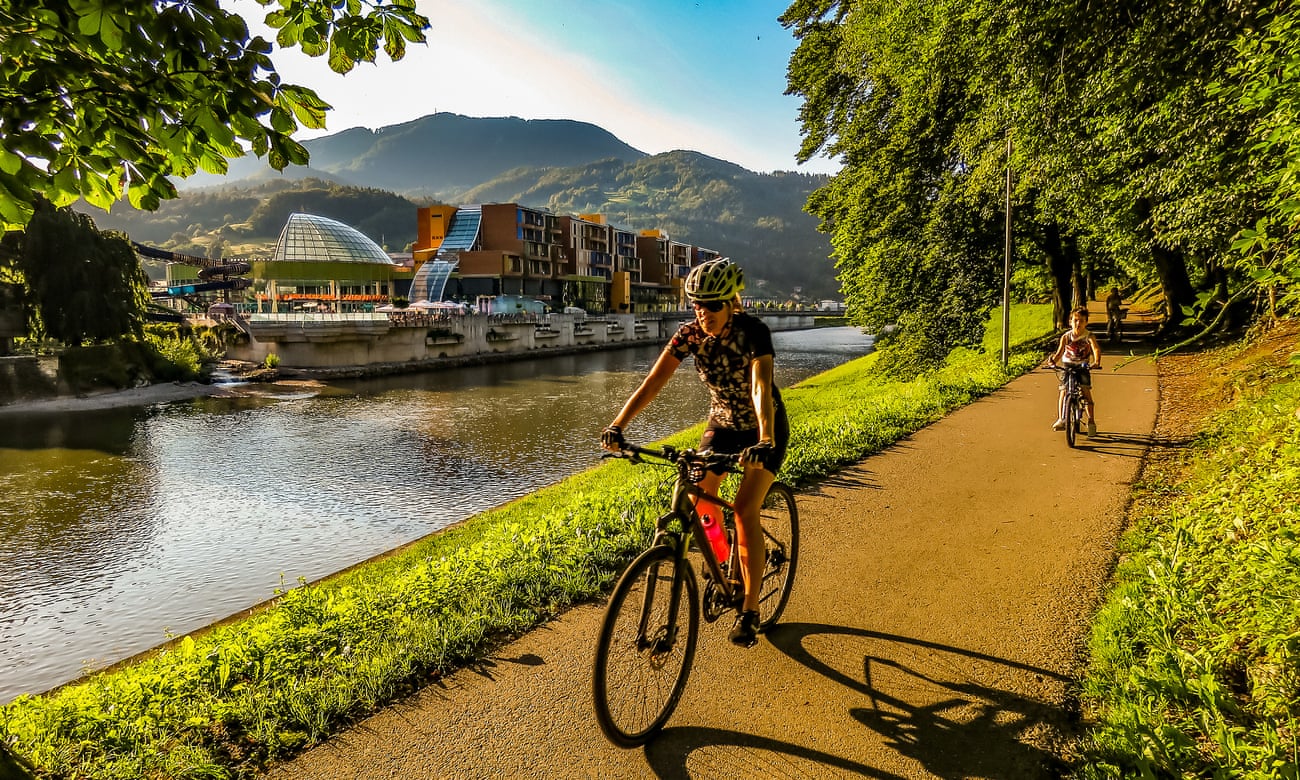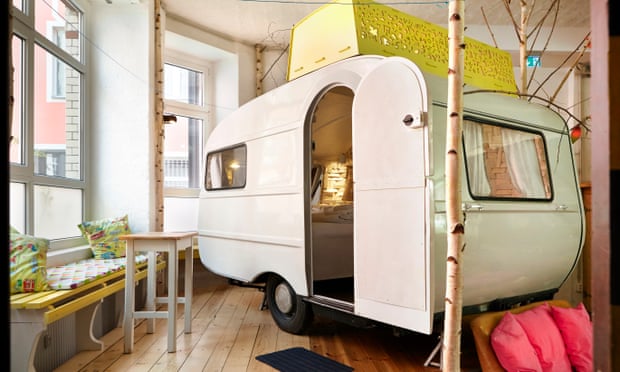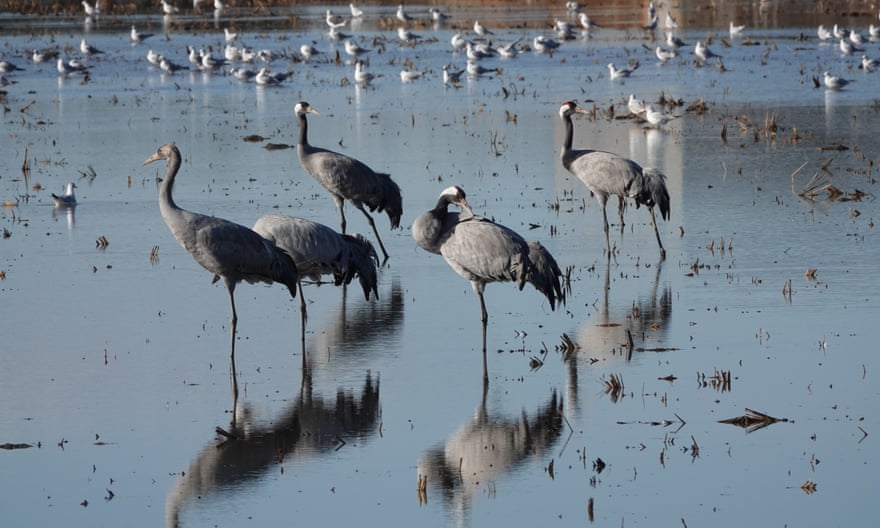Five of the best sustainable holidays across Europe
Green Wellness Route, Slovenia
This summer the country’s tourist board launched a new Green Wellness cycling route. A looping cycle trail of nearly 200 miles linking natural spas, it starts in Ljubljana and heads north towards the Austrian border and then south-west towards Croatia, winding through mountains, plains and vineyards. There’s a castle on an island, a beer fountain and miles of wild flowers. The first leg ends in medieval Kamnik, a red-roofed town of castles and monasteries with a view of the mountains, Slovenia’s biggest arboretum (sporting 2m tulips in April) and the Terme Snovik spa in the forested Tuhinj valley. Resorts along the route are all certified by Slovenia Green, which encourages recycling, renewable energy, arriving car-free, eco-friendly cleaning, locally grown food, natural building materials and so on. The spas offer pools fed by thermal springs, mineral waters to drink and wellness experiences involving salt, saunas, massage and barefoot paths. [caption id="" align="alignnone" width="648"] Slovenia launched a Green Wellness cycling route this summer, including stretches along the River Savinja[/caption]
Along the route cyclists can visit the world’s oldest noble vine at Maribor or sip a crystal glass of magnesium-rich water at Rogaška Slatina. Slovenia’s temperate Mediterranean climate means good cycling for most of the year, though April to October is recommended. The Wellness route has several companion trails, including a Green Gourmet cycling route or a three-day Pannonian route through the Pomurje region. The Gourmet trail starts with a train ride on the Bohinj railway under the Julian Alps. A free pass encourages public transport use in the area for those who want to linger.
Slovenia launched a Green Wellness cycling route this summer, including stretches along the River Savinja[/caption]
Along the route cyclists can visit the world’s oldest noble vine at Maribor or sip a crystal glass of magnesium-rich water at Rogaška Slatina. Slovenia’s temperate Mediterranean climate means good cycling for most of the year, though April to October is recommended. The Wellness route has several companion trails, including a Green Gourmet cycling route or a three-day Pannonian route through the Pomurje region. The Gourmet trail starts with a train ride on the Bohinj railway under the Julian Alps. A free pass encourages public transport use in the area for those who want to linger.
Sustainable city break in Berlin, Germany
When luggage storage company Bounce recently surveyed sustainable hotels and transport, Berlin emerged as Europe’s most eco-friendly city. According to its analysis, 84% of tourists and residents get around on bike, foot or public transport. And Germany’s summer scheme, offering unlimited travel on local and regional trains for €9, has got even more people out of their cars. [caption id="" align="alignnone" width="620"] An upcycled caravans in Neukölln’s Hüttenpalast. Photograph: Jan Brockhaus[/caption]
An upcycled caravans in Neukölln’s Hüttenpalast. Photograph: Jan Brockhaus[/caption]
From upcycled caravans to a hammock-strung hotel overlooking the zoo, Berlin is full of cool places to stayBerlin joined the Global Sustainable Tourism Council in August 2021 and Visit Berlin lists eco hotels, restaurants and sights. They include places like SPRK Deli, which makes everything from surplus food. Klub Kitchen is popular with Mitte’s hipsters, serving up salady bowlfuls of sweet potato, ginger, pumpkin seeds, edamame and other tasty things. From upcycled east German caravans in a former vacuum cleaner factory in Neukölln’s Hüttenpalast to the hammock-strung 25 Hours Bikini hotel overlooking the zoo, the city is full of cool places to stay. To explore Berlin’s wilder corners, buy an all-zone travelcard (€10 a day, including Potsdam with its parks and palaces). Buses 100 and 200 are good sightseeing routes, running from Alexanderplatz to Zoo through leafy Tiergarten. Head into the Grunewald on bus 218 to find Berlin’s best hike, the cliff-top Havelhöhenweg. Follow this six-mile waymarked walk past sandy beaches for wild swimming and leisurely woodland cafes.
YHA Festival of Walking
Those lonely months of strolls during the Covid lockdowns sparked a lot of interest in walking. The UK’s Youth Hostel Association hopes to tap into that with its new Festival of Walking. There will be group walks, routes to download, free tea or coffee for walkers, and 25% off at various youth hostels. There’s a guided Snowdon dark skies challenge – climbing up the mountain by torchlight and down as the sun rises for breakfast in the hostel. Lots of hostels, such as Eskdale in Cumbria and Blaxhall in Suffolk have been pioneering sustainable practices: energy-efficient lighting, solar hot water, and community recycling schemes. The festival runs from 4 September to 20 October. “We want more walkers to discover our hostels and all they offer,” says YHA chief executive James Blake. “Whether it’s a bed for the night, a day visit for a cuppa, filling up a bottle at a refill station, using a drying room or just grabbing a loo break.” [caption id="" align="alignnone" width="620"] A guided Snowdon dark skies challenge will feature in the festival[/caption]
Individuals and groups can log their miles on the festival website to tramp round the world in 46 days. Blake points out that if 5,000 people walk five miles each, together they will have walked around the world. The YHA was set up in 1930 to help foster a “greater knowledge, love and care of the countryside – an aim that feels as fresh and necessary as it did 92 years ago.
A guided Snowdon dark skies challenge will feature in the festival[/caption]
Individuals and groups can log their miles on the festival website to tramp round the world in 46 days. Blake points out that if 5,000 people walk five miles each, together they will have walked around the world. The YHA was set up in 1930 to help foster a “greater knowledge, love and care of the countryside – an aim that feels as fresh and necessary as it did 92 years ago.
Bird watching in Extremadura, Spain
Extremadura is one of Europe’s top birding destinations, with everything from bee-eaters to honey buzzards. The birds of prey are particularly dramatic, with 23 breeding species including 1,200 pairs of black vultures. More common cranes overwinter here than anywhere in Europe. Covering 16,000 square miles, Extremadura is bigger than the Netherlands, with a human population of just over a million and a huge range of habitats. As most visiting birders get here independently, the Extremadura tourist board set up the world’s first bird tourism club, following the model of wine or whisky routes, to help travellers find information, guides and places to stay. Travel can actually help conserve biodiversity because the bird-watching cash provides a sound economic reason to preserve habitats. [caption id="" align="alignnone" width="650"] Common crane in Extremadura[/caption]
Common crane in Extremadura[/caption]
More common cranes overwinter here than anywhere in EuropeA magnet for visiting birders since it opened in 2005, the Casa Rural El Recuerdo (three nights from €216 room-only) is a converted farmhouse with an organic olive grove and vegetable garden. The guesthouse generates half its energy from solar panels. Owners Claudia and Martin Kelsey encourage year-round wildlife trips for the large number of migrant birds, plus summer butterfly and dragonfly tours. As a local guide, Martin can take visitors to see species they want to find without having to drive too far, meaning less fuel and more time in the field.
Green Velo, Poland
With more than a thousand miles of linked cycle paths and quieter roads through wild natural landscapes, Poland’s longest fully-signed bicycle trail tours the country’s eastern areas. Five regions, with funding from the European Regional Development Fund, cooperated to create the epic Green Velo trail. Miles of cycle path have been designed to be low-maintenance with no impact on water supplies or vegetation; there are benches, refill points, bike racks and rubbish bins. Accommodation varies from campsites to castles. [caption id="" align="alignnone" width="648"] The Green Velo trail passes through marshes near the Narew River[/caption]
The trail meanders through 12 areas or “bike kingdoms”, such as the Świętokrzyski national park, with its huge forests and mountains. In another kingdom, the marshes around the Biebrza and Narew rivers are great for birdwatching and elk spotting, for cycling past gold marsh marigolds and purple Siberian iris. The waymarked Green Velo route circles the edge of protected valleys, with views across the spring-flowering marshes. There are bats, beavers and lots more wildlife along the Narew valley towards Łomża with its convent and cathedral.
Other attractions along the route include the mysterious Krzyżtopór castle near Ujazd, and the city of Kielce, with its palaces and galleries. The Green Velo loops through the centre of Kielce, passing the Kadzielnia Reserve in a limestone quarry; there are concerts here in a natural amphitheatre among fossil-filled rocks.
The Green Velo trail passes through marshes near the Narew River[/caption]
The trail meanders through 12 areas or “bike kingdoms”, such as the Świętokrzyski national park, with its huge forests and mountains. In another kingdom, the marshes around the Biebrza and Narew rivers are great for birdwatching and elk spotting, for cycling past gold marsh marigolds and purple Siberian iris. The waymarked Green Velo route circles the edge of protected valleys, with views across the spring-flowering marshes. There are bats, beavers and lots more wildlife along the Narew valley towards Łomża with its convent and cathedral.
Other attractions along the route include the mysterious Krzyżtopór castle near Ujazd, and the city of Kielce, with its palaces and galleries. The Green Velo loops through the centre of Kielce, passing the Kadzielnia Reserve in a limestone quarry; there are concerts here in a natural amphitheatre among fossil-filled rocks.
Source The Guardian